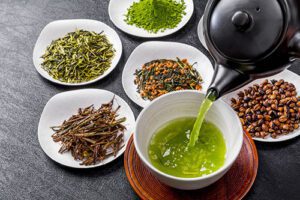Gyokuro is a variety of shade-grown green tea that is made only in Japan. It is a tea you shoulf try if you already enjoy other Japanese green teas like sencha and matcha. I also recommend it for people who are looking for tea without bitterness.
How to prepare it.
Gyokuro is usually harvested around the end of May. Processing is largely the same as other steamed green teas with one crucial difference. The leaves are shaded for approximately 20 days before harvesting. This process increases the amount of caffeine and L-theanine, which contributes to the umami taste. Gyokuro leaves are more tender so they require a bit more care than an un-shaded tea would. They are lightly steamed to prevent oxidation and then rolled for several hours. This is what gives Japanese teas their distinctive needle-like shape. Once the rolling step is complete the leaves are dried. It is considered aracha, or rough tea, until the stems have been removed. The stems from gyokuro can be used to make another type of tea called karigane.
Good quality gyokuro will be dark green in color with a glossy appearance
Where does it come from?
Gyokuro can only be made in Japan. The tea would not taste the same if grown elsewhere, even if the same processing steps are followed, because of the terroir. The best-known production places for this tea are Kyoto, Fukuoka, and Shizuoka Prefectures. It is not common to find shade-grown tea from other regions but they do exist.
How does it taste;
Gyokuro has a very unique taste. It is delicate yet full-bodied at the same time. It is grassy with notes of seaweed and an intense savory sweetness called umami. There should be no bitterness or astringency. In comparison to sencha, it is smoother with a thicker mouthfeel and lingering aftertaste. A good quality gyokuro can be re-steeped several times.
Gyokuro leaves are very tender so you can actually eat them after they are steeped out. Seriously! Try making a little salad with ponzu sauce. I like to mix them with plain white rice. They are also tasty in an omelet in place of spinach.
Storing your gyokuro properly is important for preserving the taste. Avoid exposing it to heat, light, and moisture as much as possible.
How to brew it!
Gyokuro can be a bit fussy to brew so slow and low is the best way to go. It is also traditionally brewed in small quantities.
For a 250 ml tea mug you will need approx 2g of tea and 70 °C water!
For multiple infusions use 5g of tea for every 50ml of water. Water is usually about 70°C with a first infusion of 30-45 seconds. Pour the water slowly to avoid agitating the leaves too much. Also, make sure to pour out every precious drop of tea. For subsequent steeps, increase gradually both the temperature and water volume.
As with any tea, there is no right or wrong way to make gyokuro. What matters is that you enjoy the taste!




